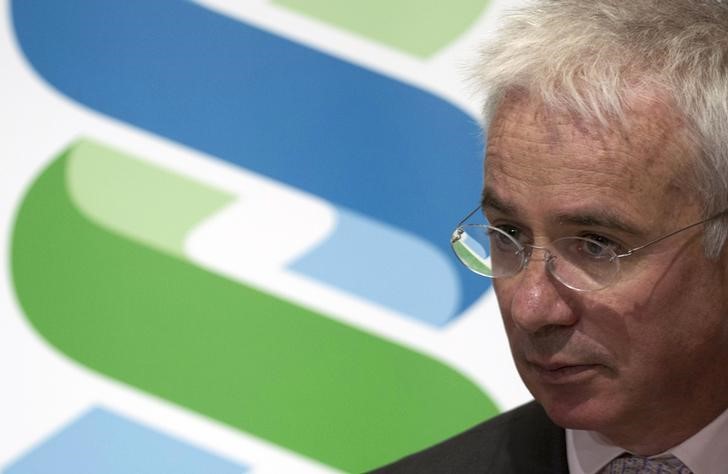By Steve Slater and Lawrence White
LONDON/HONG KONG (Reuters) - In summer 2012 Peter Sands was flying high as Standard Chartered (L:STAN) Chief Executive, batting back questions on whether he was tempted to run Barclays (L:BARC) or even the Bank of England.
Praised for steering a safe path through the financial crisis, the former McKinsey consultant had just delivered bumper half-year earnings to set his Asia-focused bank on course for a 10th straight year of record profits.
But days later, when Sands had gone on holiday, New York's bank regulator accused the bank of being a "rogue institution" that hid $250 billion in transactions tied to Iran and left the United States vulnerable to terrorists.
It was the start of a run of trouble that saw Sands ousted on Thursday following a rebellion by key shareholders.
Investors cited failures in strategy, execution and governance, leaving new CEO Bill Winters with a lot to do.
Investors have said Chairman John Peace needs to share the blame for Standard Chartered losing its sparkle, and he is leaving in 2016 once Winters has settled in.
Critics said Sands, 53, too often blamed external factors, such as changes in Korean law or tougher global regulations, and failed to restructure the bank quickly.
They said he was good at growing the bank, but failed to axe jobs and businesses when Asian growth stalled.
Sands survived 2013, sustained by his record of making good returns for shareholders, but by early 2014 some top investors were privately talking about replacing him.
It was suggested he might become chairman, but he said he had no interest in that and pressed ahead with plans to get the bank back on track.
Disquiet about the pace and depth of change grew as the year progressed, and behind the scenes, the bank's second biggest shareholder Aberdeen Asset Management was agitating for change.
Its biggest investor, Singapore sovereign wealth fund Temasek, meanwhile, had long voiced concerns about governance.
By the end of last year, Aberdeen's CEO Martin Gilbert was pressing Peace to replace Sands, a source familiar with the situation told Reuters. Gilbert also told Sands he should go.
In December the board decided change was needed, another source said. They wanted a successor before the annual general meeting in May, otherwise another fiery shareholder gathering was inevitable.
Headhunter Egon Zehnder was tasked with finding the successor. Sands was aware of the process, a source said.
Sands, with his spiky white hair and Harry Potter spectacles, grew up in Asia and previously worked for the British Foreign Office and McKinsey.
ON THE ROPES
Insiders said Standard Chartered has been on the ropes ever since New York's regulator launched its broadside.
The bank's response was typical of a company that did not deal well with bad news: it felt hard done by.
It paid a fine of $667 million and avoided losing its state banking licence. But the row left the bank slow to respond when more problems arrived. Its 19-member board looked unwieldy and reluctant to challenge management, investors said.
The bank had also aggressively increased its lending during its boom era, and rival bankers said it appeared to relax lending standards and carried some major single name exposures.
Losses from bad loans rose last year, and investors fear there could be more problems from $61 billion of loans to commodities companies, built up over the last five years.
Other problems have surfaced. Staff morale is said to be low; several senior executives left, including finance director Richard Meddings; and more than 40 percent of shareholders rebelled against the pay plan at last year's AGM.
Yet the bank remained profitable, unlike many rivals, and its expected 2014 profit of about $5.7 billion is double its level when Sands became CEO.
Sands set out plans to cut $400 million in annual costs and 4,000 jobs, including taking out layers of management and shutting some areas, including its loss-making equities business.
But analysts expect Winters to cut more of the bank's 89,000 staff, which has doubled under Sands, and also quickly address whether to raise capital. Sands has resisted calls to raise cash, in contrast to 2008, 2009 and 2010 when he moved quickly when funds were needed to improve capital and grow the business.
Standard Chartered's shares have almost halved in the past two years, against a 19 percent rise in the European bank index (SX7P). That has undone much of Sands' good work in his first five years, leaving shares down a fifth since he became CEO in November 2006.
"Sands did very well, but he was there too long. The board supported everything he did so the guy feels he is walking on water and that lowers your guard," said a senior banker at a rival firm.
Investors welcomed the appointment of Winters, but some said the bank may need to go further and consider moving to Singapore or Hong Kong to re-orient itself towards Asia.
The bank has said it keeps its domicile under review, and London has remained its preferred home in recent years.
Sands admitted on Thursday the last two years had been difficult but put a brave face on his exit.

"It was always our intention to begin a handover process around now ... now is the right time for me to hand over," he said.